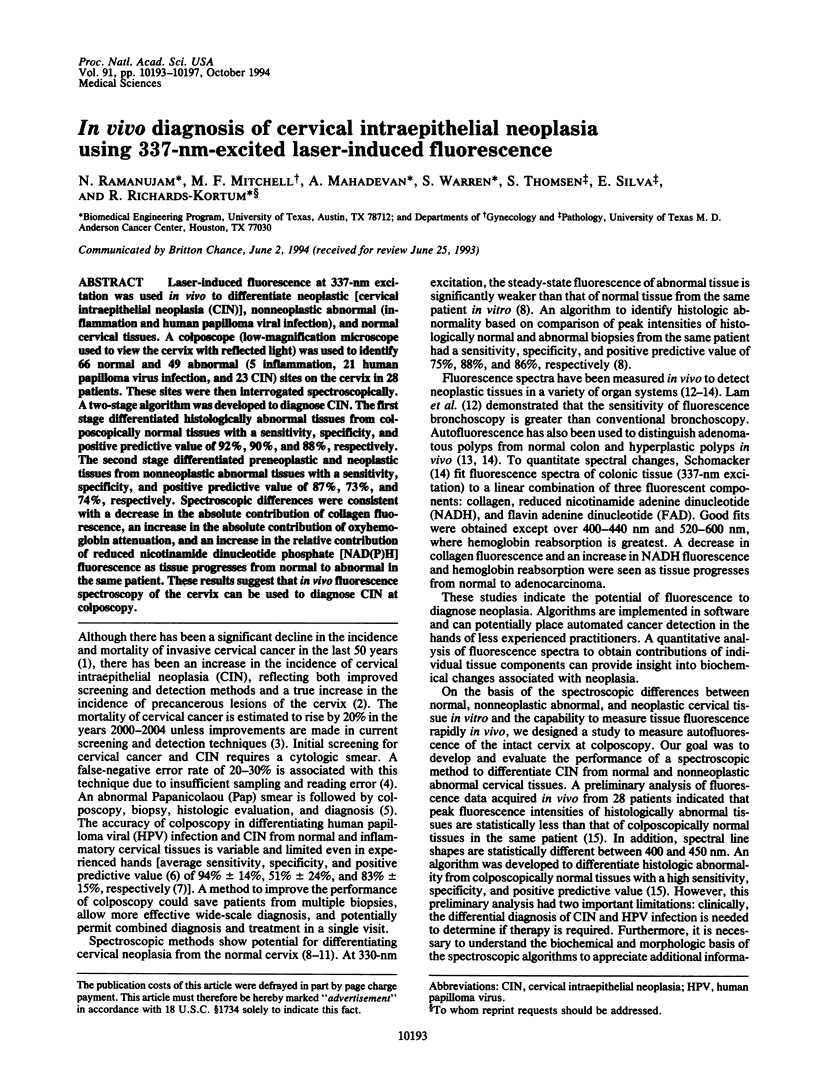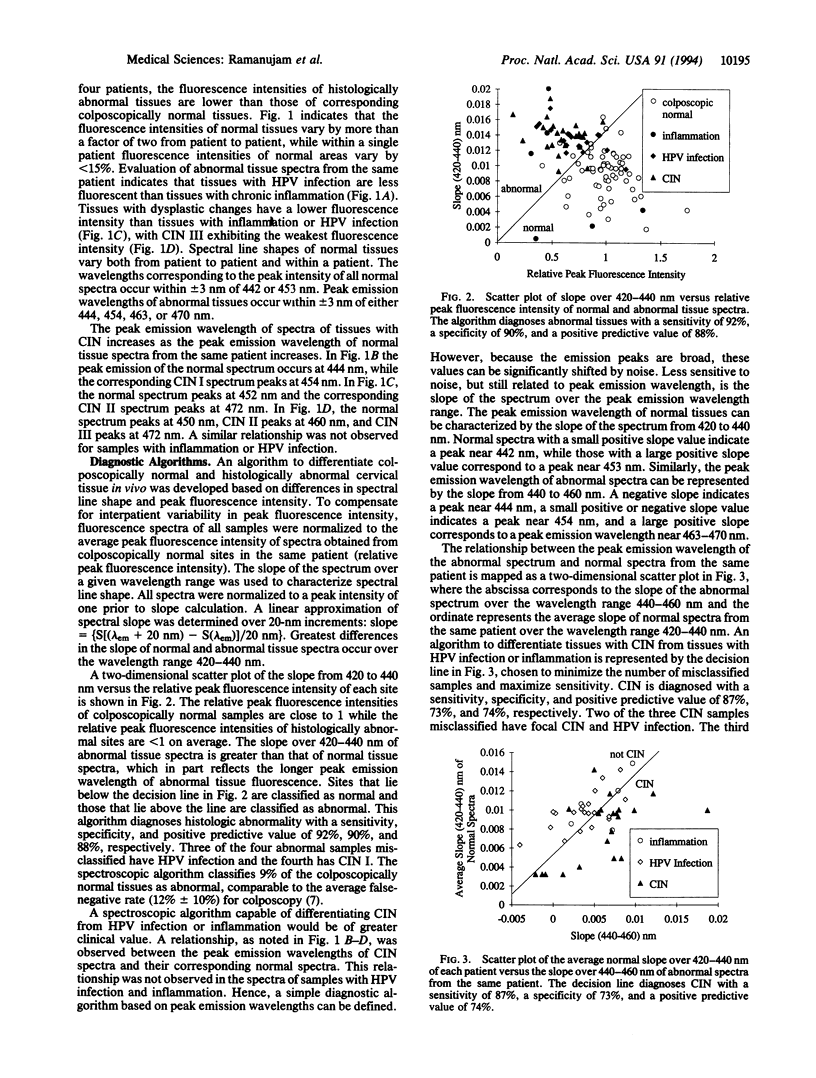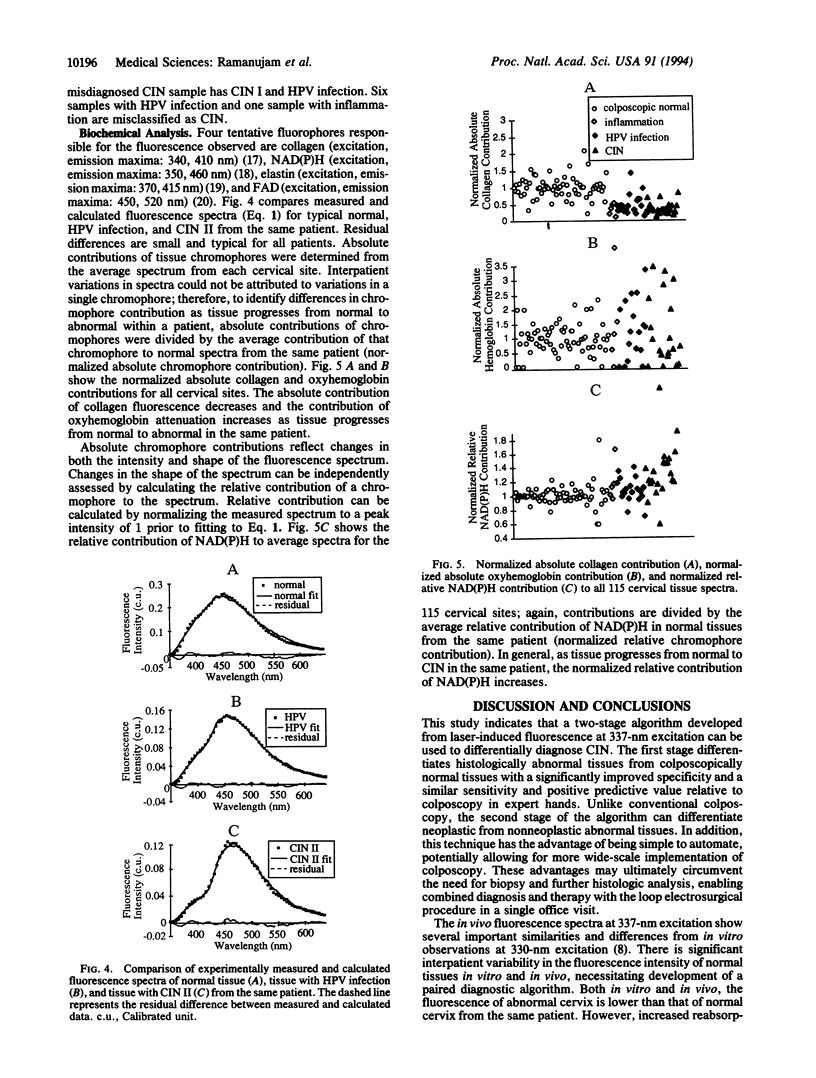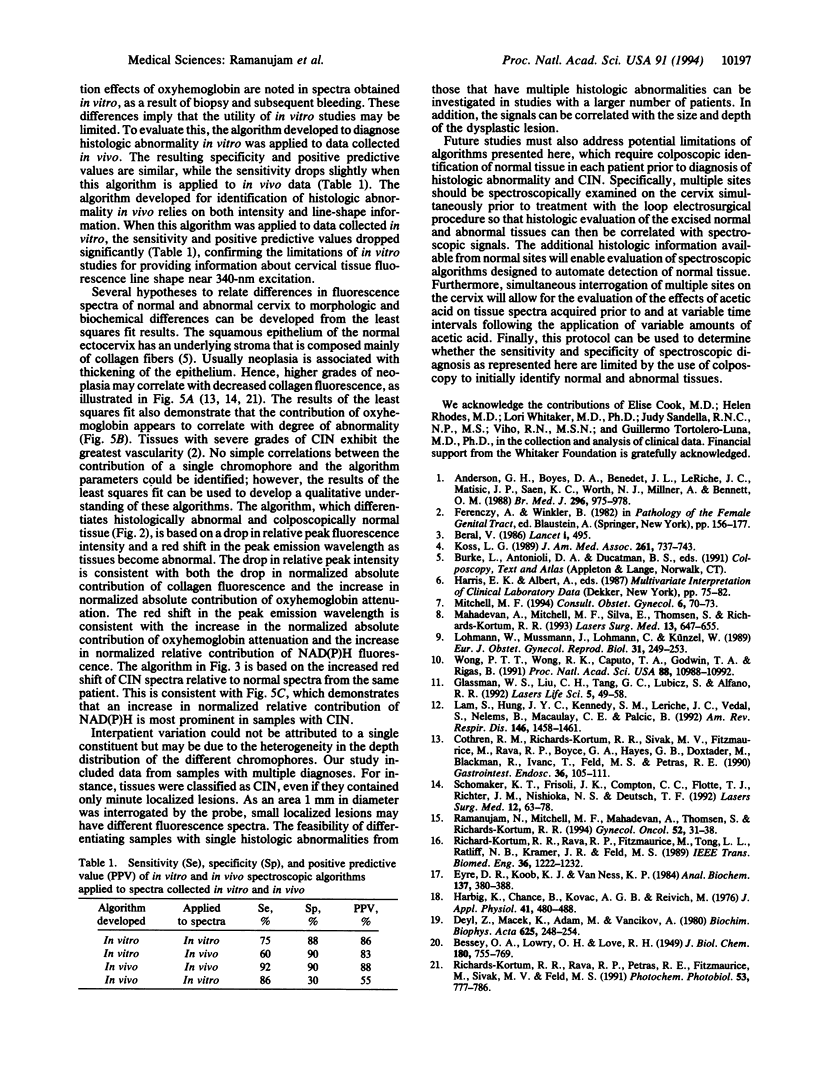Abstract
Laser-induced fluorescence at 337-nm excitation was used in vivo to differentiate neoplastic [cervical intraepithelial neoplasia (CIN)], nonneoplastic abnormal (inflammation and human papilloma viral infection), and normal cervical tissues. A colposcope (low-magnification microscope used to view the cervix with reflected light) was used to identify 66 normal and 49 abnormal (5 inflammation, 21 human papilloma virus infection, and 23 CIN) sites on the cervix in 28 patients. These sites were then interrogated spectroscopically. A two-stage algorithm was developed to diagnose CIN. The first stage differentiated histologically abnormal tissues from colposcopically normal tissues with a sensitivity, specificity, and positive predictive value of 92%, 90%, and 88%, respectively. The second stage differentiated preneoplastic and neoplastic tissues from nonneoplastic abnormal tissues with a sensitivity, specificity, and positive predictive value of 87%, 73%, and 74%, respectively. Spectroscopic differences were consistent with a decrease in the absolute contribution of collagen fluorescence, an increase in the absolute contribution of oxyhemoglobin attenuation, and an increase in the relative contribution of reduced nicotinamide dinucleotide phosphate [NAD(P)H] fluorescence as tissue progresses from normal to abnormal in the same patient. These results suggest that in vivo fluorescence spectroscopy of the cervix can be used to diagnose CIN at colposcopy.
Full text
PDF




Selected References
These references are in PubMed. This may not be the complete list of references from this article.
- Anderson G. H., Boyes D. A., Benedet J. L., Le Riche J. C., Matisic J. P., Suen K. C., Worth A. J., Millner A., Bennett O. M. Organisation and results of the cervical cytology screening programme in British Columbia, 1955-85. Br Med J (Clin Res Ed) 1988 Apr 2;296(6627):975–978. doi: 10.1136/bmj.296.6627.975. [DOI] [PMC free article] [PubMed] [Google Scholar]
- BESSEY O. A., LOWRY O. H., LOVE R. H. The fluorometric measurement of the nucleotides of riboflavin and their concentration in tissues. J Biol Chem. 1949 Sep;180(2):755–769. [PubMed] [Google Scholar]
- Beral V., Booth M. Predictions of cervical cancer incidence and mortality in England and Wales. Lancet. 1986 Mar 1;1(8479):495–495. doi: 10.1016/s0140-6736(86)92944-2. [DOI] [PubMed] [Google Scholar]
- Cothren R. M., Richards-Kortum R., Sivak M. V., Jr, Fitzmaurice M., Rava R. P., Boyce G. A., Doxtader M., Blackman R., Ivanc T. B., Hayes G. B. Gastrointestinal tissue diagnosis by laser-induced fluorescence spectroscopy at endoscopy. Gastrointest Endosc. 1990 Mar-Apr;36(2):105–111. doi: 10.1016/s0016-5107(90)70961-3. [DOI] [PubMed] [Google Scholar]
- Deyl Z., Macek K., Adam M., Vancíková O. Studies on the chemical nature of elastin fluorescence. Biochim Biophys Acta. 1980 Oct 21;625(2):248–254. doi: 10.1016/0005-2795(80)90288-3. [DOI] [PubMed] [Google Scholar]
- Eyre D. R., Koob T. J., Van Ness K. P. Quantitation of hydroxypyridinium crosslinks in collagen by high-performance liquid chromatography. Anal Biochem. 1984 Mar;137(2):380–388. doi: 10.1016/0003-2697(84)90101-5. [DOI] [PubMed] [Google Scholar]
- Harbig K., Chance B., Kovách A. G., Reivich M. In vivo measurement of pyridine nucleotide fluorescence from cat brain cortex. J Appl Physiol. 1976 Oct;41(4):480–488. doi: 10.1152/jappl.1976.41.4.480. [DOI] [PubMed] [Google Scholar]
- Koss L. G. The Papanicolaou test for cervical cancer detection. A triumph and a tragedy. JAMA. 1989 Feb 3;261(5):737–743. [PubMed] [Google Scholar]
- Lam S., Hung J. Y., Kennedy S. M., Leriche J. C., Vedal S., Nelems B., Macaulay C. E., Palcic B. Detection of dysplasia and carcinoma in situ by ratio fluorometry. Am Rev Respir Dis. 1992 Dec;146(6):1458–1461. doi: 10.1164/ajrccm/146.6.1458. [DOI] [PubMed] [Google Scholar]
- Lohmann W., Mussmann J., Lohmann C., Künzel W. Native fluorescence of the cervix uteri as a marker for dysplasia and invasive carcinoma. Eur J Obstet Gynecol Reprod Biol. 1989 Jun;31(3):249–253. doi: 10.1016/0028-2243(89)90160-3. [DOI] [PubMed] [Google Scholar]
- Mahadevan A., Mitchell M. F., Silva E., Thomsen S., Richards-Kortum R. R. Study of the fluorescence properties of normal and neoplastic human cervical tissue. Lasers Surg Med. 1993;13(6):647–655. doi: 10.1002/lsm.1900130609. [DOI] [PubMed] [Google Scholar]
- Ramanujam N., Mitchell M. F., Mahadevan A., Thomsen S., Silva E., Richards-Kortum R. Fluorescence spectroscopy: a diagnostic tool for cervical intraepithelial neoplasia (CIN). Gynecol Oncol. 1994 Jan;52(1):31–38. doi: 10.1006/gyno.1994.1007. [DOI] [PubMed] [Google Scholar]
- Richards-Kortum R., Rava R. P., Fitzmaurice M., Tong L. L., Ratliff N. B., Kramer J. R., Feld M. S. A one-layer model of laser-induced fluorescence for diagnosis of disease in human tissue: applications to atherosclerosis. IEEE Trans Biomed Eng. 1989 Dec;36(12):1222–1232. doi: 10.1109/10.42117. [DOI] [PubMed] [Google Scholar]
- Richards-Kortum R., Rava R. P., Petras R. E., Fitzmaurice M., Sivak M., Feld M. S. Spectroscopic diagnosis of colonic dysplasia. Photochem Photobiol. 1991 Jun;53(6):777–786. doi: 10.1111/j.1751-1097.1991.tb09892.x. [DOI] [PubMed] [Google Scholar]
- Schomacker K. T., Frisoli J. K., Compton C. C., Flotte T. J., Richter J. M., Nishioka N. S., Deutsch T. F. Ultraviolet laser-induced fluorescence of colonic tissue: basic biology and diagnostic potential. Lasers Surg Med. 1992;12(1):63–78. doi: 10.1002/lsm.1900120111. [DOI] [PubMed] [Google Scholar]
- Wong P. T., Wong R. K., Caputo T. A., Godwin T. A., Rigas B. Infrared spectroscopy of exfoliated human cervical cells: evidence of extensive structural changes during carcinogenesis. Proc Natl Acad Sci U S A. 1991 Dec 15;88(24):10988–10992. doi: 10.1073/pnas.88.24.10988. [DOI] [PMC free article] [PubMed] [Google Scholar]


